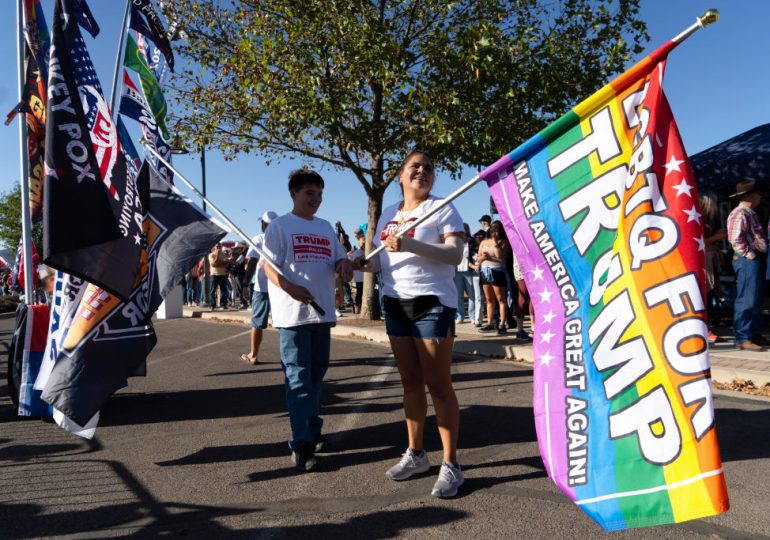After tapping into the“manosphere” of podcast listeners and college fraternities, the Trump-Vance campaign succeeded in winning over young male voters, exit polls suggest. But the conservative vision of masculinity that won over unexpected numbers of Gen Z voters wasn’t aimed at just the stereotypical bros—a fact that Vice President-elect J.D. Vance nodded at with his suggestion that the Republican ticket could also win the “normal gay guy vote.”
[time-brightcove not-tgx=”true”]
Coming from the party pushing forward anti-LGBTQ legislation at historic speeds, conditional approval of some gay men may appear entirely contradictory—and, indeed, the LGBTQ vote appears to have gone strongly in the Democrats’ favor. However, as history shows, conservative masculinity’s reliance on traditional gender roles can coexist with embrace of certain aspects of gay identity.
Consider the case of Germany and the rise of the Nazis, which depended on both the construction of the ideal man and male comradeship—both of which carried potentially homoerotic dimensions.
Read More: What It Means to Be a Man, According to UFC’s Dana White
Years before, interwar gay politics was deeply divided, not least along ideological lines. The Scientific Humanitarian Committee, Germany’s first gay rights organization, founded in 1897 by sexologist Magnus Hirschfeld, courted left-leaning Social Democratic support. It saw scientific enlightenment as key to its arguments for acceptance of queer and trans people. Despite pervasive homophobia, the organization succeeded in winning some parliamentary support for gay rights, which came almost exclusively from the left. While ultimately unsuccessful, in 1929, it was the Social Democratic Party that introduced legislation to decriminalize homosexuality.
In contrast, gay publisher and organizer Friedrich Radszuweit rooted his League of Human Rights, established in 1920, in liberal ideals. An activist and businessman, Radszuweit saw liberal centrists as protecting both private life and private enterprise from state regulation. Both were also conducive to a version of respectability politics that were ambivalently promoted in his magazines.
And yet, there was also some gay support for Nazi and right-wing political movements during the 1920s and 1930s. And support went both ways. Already in 1917, gay writer and self-described “masculinist” Hans Blüher argued that erotic bonds between men were more important than heterosexual family units to the creation of a masculine social community. This“Männerbund” or “men’s collective,” advocated the creation of a racially pure “Volksgemeinschaft,” or “people’s community,” predicated on imagined biological belonging to a fictional “Aryan” race.
So too did the Sturmabteilung (SA) or Stormtroopers. Not only was the leader of the Nazi paramilitary organization, Ernst Röhm, widely known to be gay, but the SA forged a politics of masculinity that depended on homosocial bonding and the aestheticization of the male form. Different from “homosexuality,” which was associated with femininity, Judaism, and Marxism, “manly eros” won support from men who had sex with men. Although homosexuality was violently excised from the SA in the 1934 “Night of the Long Knives,” camaraderie between men continued to provide ammunition for left-wing detractors.
Critics on the left—social democrats and communists—ridiculed fascism as homosexual. Sexual perversity, they argued, was part of the political perversity that they identified, and thus homophobia became a tool to discredit right-wing movements generally and the Nazis specifically.
However, some gay men’s defense of erotic comradeship did not constitute an acceptance of homosexuality in the ranks of the Nazi party. Nor did the apparent homoeroticism that ran through Nazi cultural institutions necessarily represent the sign of latent homosexual desire. Instead, the priority of masculinity sought to exclude and undermine femininity, resulting in the sexual subjugation of women; the persecution of same-sex desiring men, women, and trans people; and the creation of a Volksgemeinschaft that could only be realized through the genocide of Jews, Roma, and Sinti. While these groups were persecuted differently, they were persecuted nonetheless.
The paradox at the heart of Nazi homoeroticism—between the adoption of staples of gay masculinism and the violent rejection of homosexuality—resulted in the sexual subordination of women. While many Weimar-era (1919-1933) gay activists sought alliances with feminists, lesbian and straight alike, masculinists argued that women’s’ sexuality should prioritize reproduction in service of building an “Aryan” race. Male bonding in service to the state gave racially privileged men sexual license and political initiative, while women were expected to focus their sexual energy on producing “racially fit” children. This did not exclude things like premarital sex, which appealed to both young men and young women, but the strategic breakdown of sexual mores did not translate to women’s emancipation.
The fixation of hypervirility of “Aryan” men also allowed for rule breaking. Soldiers were tacitly permitted to have sex with “non-Aryan” women—which in practice often meant assault—provided that sexual contact did not result in children. The same logic also resulted in deep confusion about sexual contact between men. Sex between men was subject to the death penalty within the Schutzstaffel (SS) after Germany’s 1941 invasion of the Soviet Union. Yet assumptions about masculine sexual virility meant that some sexual acts were not necessarily seen as punishable, even as homosexual “effeminacy” was to be physically exterminated. Contradictory impulses in Nazi views on masculinity made it impossible to police when much-vaunted male camaraderie crossed the line into unacceptable homoerotic intimacy, precisely because there was no clear line to begin with.
Read More: The False Idea Behind Project 2025’s Plans for LGBTQ Rights
Just like the politics that structure them, Nazi masculinity of the 1940s and U.S. conservative masculinity of the 2020s are not the same.
However, the German case helps us understand some of its contradictions and consequences. Rather than undermining right-wing movements, the contradictions of masculinity in Weimar and Nazi Germany upheld them. They were also part of the appeal. Today, the Republican Party, and the incoming Trump-Vance administration in particular, offer young men a version of masculinity that prioritizes their sexual prerogative, which can, at times, include “normal gay guys.”
Like before, it will also mean the subordination of women. The fact that Vice President Harris won a higher percentage of LGBTQ voters than any presidential candidate in recent history requires us to make a distinction between “manly eros” and gay rights. Indeed, the contradictions of conservative masculinity are key to its appeal.
Christopher Ewing is an assistant professor of history at Purdue University. His research examines sexuality, race, and crime in modern Germany and Europe.
Made by History takes readers beyond the headlines with articles written and edited by professional historians. Learn more about Made by History at TIME here. Opinions expressed do not necessarily reflect the views of TIME editors.
Leave a comment








